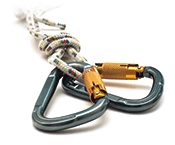Indoor rock climbing can be an enjoyable and healthy exercise for everyone, even people with bleeding disorders. Because technique is more important than physical fitness, almost anyone of any age or ability can try it.
Chris Bombardier is a big advocate of indoor rock climbing. Bombardier, who has severe hemophilia B, discovered rock climbing after graduating from college. “It’s a great way for people with bleeding disorders to have fun, build confidence and stay in shape,” he says. Bombardier and the National Hemophilia Foundation (NHF) Colorado Chapter founded Backpacks & Bleeders community rock-climbing program in 2013.
The Basics
Indoor climbing is a safer alternative to outdoor rock climbing because it’s done in a controlled environment. NHF’s publication “Playing It Safe: Bleeding Disorders, Sports and Exercise,” ranks indoor rock climbing as a level 2, or moderate-risk, physical activity. The primary danger associated with climbing is falling. Although in an indoor setting with proper equipment, instruction and supervision, the risk of falling is minimal.
Climbing typically involves two people: the climber and the belayer. The climber wears a harness with a rope fastened to it via a carabiner attached to the ceiling. A carabiner is a small, sturdy metal clip. The belayer on the ground keeps the rope tight as the climber heads up the wall.
Rock walls can range in height from 20 to 60 feet. They can be made of any number of materials, including plywood, multiplex board and aluminum. Built-in climbing holds allow climbers to grab or position their feet in them as they ascend. The holds are often closer together on walls for beginners, and spaced farther apart on more advanced walls. The time it takes to ascend and descend a wall depends on the wall’s height and the climber’s skill level.
Certain specialized equipment is necessary for indoor climbing. Most indoor climbing gyms rent the equipment to you. Essentials of climbing include:
- A climbing harness. This is fastened around your waist and secures you to the rope. It is typically made of nylon.
- A belaying device. This controls your rope while climbing and acts as a friction break to prevent falls. With a sturdy belaying device, a belayer can stop the fall of a much heavier climber.
- A locking carabiner. A small, sturdy metal clip used to fasten the belaying device to your harness.
- A chalk bag. Slippery, sweaty palms can be dangerous while climbing. Rubbing powdered chalk on your hands helps keep them dry. You can attach a chalk bag to your harness while you climb.
When climbing, you should wear comfortable clothes that do not inhibit your mobility—capris and yoga pants for women, and knee-length shorts for men. You don’t want your clothes to be baggy, though. “If you have a very loose top, it could get in the way of the ropes, which could be a safety concern,” warns Sean Jeffrey, 25, a rock climber with hemophilia. “The harness can slide around and sometimes even pinch when clothing wrinkles get in the way,” adds the Colorado native. Most gyms rent special climbing shoes. These have stiff rubber soles that extend up and over the toes.
With a bleeding disorder, you may need to take extra precautions before climbing. “Infuse if your medical team thinks it is wise,” Jeffrey says. “Know your ability level, the routes you are going to climb and the proper equipment you need.”
 Benefits of Indoor Climbing
Benefits of Indoor Climbing
Indoor rock climbing is ideal for people who want to learn at their own pace. “You get to decide your challenge,” says Bombardier. Most gyms have routes that vary in skill level, from beginner to expert. It’s important to know where you stand. Pushing yourself too hard early on can result in injuries. But incrementally increasing the difficulty of your climbs will allow you to improve your skills and track your progress.
Regular climbing works many muscles. “Rock climbing builds muscle strength and endurance, and not just of your upper body. A good climber effectively utilizes their leg and core muscles,” says Laura Fox, DPT, at the University of Colorado Hemophilia and Thrombosis Center in Aurora.
Beyond simply physical development, rock climbing also teaches patience, planning and analysis. Even in an indoor environment, climbing requires significant concentration and focus. “There is a lot of problem solving and planning involved in a successful climb,” Fox says. “Conquering those walls is great brain training and provides a sense of accomplishment.”
There are many social aspects to indoor rock climbing as well. The gym provides a place to meet people with similar interests. Climbing also demands a degree of trust and teamwork, as one person belays while the other one climbs. This makes rock climbing a satisfying sport to do with a group of friends or family members. Working with others to achieve a goal or overcome an obstacle can be a very rewarding experience. “Indoor rock climbing is a perfect way for people with hemophilia to feel empowered,” says Bombardier.
Becoming Rock Solid
To get started, find a local rock-climbing gym near you. Look for a gym that has trained, certified instructors. Climbing instructors are typically certified by the American Mountain Guides Association (AMGA), and have a deep knowledge and understanding of all aspects of climbing. They can teach you the fundamentals of climbing safely. “Once you go through that class and do your first climb with the instructors, it really opens up a whole new world to you,” Bombardier says.

